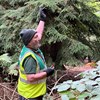Visit to Sheffield Park by South East and London Volunteers

Observatree Lead Volunteer South East England
Lead Observatree Volunteers, Ben and Richard arranged a winter activity for the south east region to enable volunteers to meet up and socialise, exchange knowledge and experiences whilst out on site. The invitation was also extended to Stephen and his London-based colleagues. In total, nine Observatree Volunteers visited Sheffield Park estate and were made welcome by the Tree Ranger, Matt Phelvin and Assistant Head Gardener, Chris Skinner. Both took time out to explain the challenges and the joys of managing this huge National Trust estate of 300+ acres in deepest Sussex.
There is a wide range of mature trees on the site as well as some amazing veteran sweet chestnuts with up to five 'cuckoo' saplings growing on them. The garden is famous for its autumn colour with highlights form Dawn Redwood Sequoiadendron glyptostroboides and Swamp Cypress Taxodium distichum and an extensive collection of Tupelo Nyssa sylvatica. We were also introduced to the Chilean Plum Yew Prumnopitys andina which was looking largely dead but apparently this is typical in the UK as the tree gets established and it can photosynthesise through the brown leaves and stems.
February is not the best time for a display most noted for its autumn colour, but it gave the challenge of winter ID of deciduous trees. Further ID opportunities were presented by the varied collection of conifers. The group exchanged knowledge and experience as we made slow progress around the grounds and everyone came away with better knowledge and awareness of tree species. Ideas were swapped on ways to distinguish the most frequent cypresses (appropriate with January’s host of the month being Lawson cypress) while the more exotic specimens needed someone to find the name tags. But occasionally, and under some peer pressure, Stephen produced his battered, but clearly-loved copy of Collins Tree Guide.
No great discoveries of Priority Pests or Diseases were found. Unusual scars had been left on beech trees from foraging by squirrels with 'wart-like' patches of callus within the damaged areas. We also found what appeared to be Common Tar Crust Diatrype stigma on Beech as well as some low (below 1 metre) woodpecker scars.
The site had been subject to surveillance for Phytophthora ramorum on Rhododendron ponticum and Kalmia spp. but staff had managed the gardens to reduce risks. Chris Skinner explained that R. ponticum is the favoured host of this organism but the less susceptible cultivars could be retained and flourished. He also told us how the plant range is being steered away from Asiatic species in favour of N. & S. American and Australian plants on account of climate influence and potential pest or disease pressure.
There are a number of Wellingtonia Sequoia gigantea on the site and one of the largest was struck by lightning last autumn. The lower trunk of the tree was left standing and it creates a dramatic visual reminder of the power involved in its demise.
After a busy, informative and enjoyable day, everyone left the site with a few new insights into the trees that we had seen and shared experience of surveying trees. We would like to thank our friends at the National Trust for hosting us.
